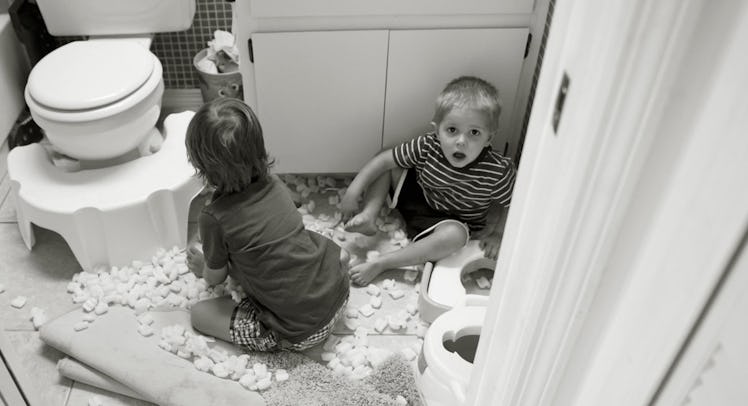How to Discipline More Than One Kid at Once
More kids mean more problems and some logistical concerns in terms of punishment.

Disciplining a single child is a relatively straightforward task if you have a time-out spot, a willingness to talk, and some patience. But once a family of three becomes a family of four, discipline gets an audience. With another child in the room (or the next room, kids eavesdrop) there’s a new set of considerations: Where does everyone go for time outs? Who gets what punishment? How does behavior normalize after a conflict?
The most likely reason more than one kid will be disciplined is kid-on-kid conflict—aggressive toy tussles, shoving match, and the like. These are instances where both parties are culpable, but that doesn’t have to mean punishments for all the people. In fact, family counselor Jaime Malone recommends punishing the toy (so to speak). “By removing the object, this naturally leads to a focus and behavior change among the children,” she explains “With their focus shifting to find something else to do, it gives an opportunity for the fighting to also stop.”
READ MORE: The Fatherly Guide to Raising Brothers and Sisters
But sometimes there isn’t an object involved. People are people and little people can be particularly small, so stuff happens. The key isn’t trying to avoid that inevitability but to react logically and calming. While adults may like to think that the bigger kid is most likely the instigator, it’s important to note that little kids can also be responsible for starting a dust-up—and often are because they lack the skills required to de-escalate.
“Younger children often focus on the other child’s behavior rather than their own,” explains Malone. “‘I hit him because he hit me’ is all too common.” She says that parents should already be helping kids, particularly siblings, understand there are better choices than lashing out when dealing with heightened emotions. Likewise, they should already have expectations about consequences when a child chooses violence over telling their adversary to stop, walking away from the conflict, or getting help from an adult.
When these consequences are clear, Malone explains, an older kid will be able to name and self-administer the consequences they already know are in store. They can simply be told to go into time out, for instance without being monitored. “This gives the parent the opportunity to monitor the consequence for the younger child,” she says.
But whatever those consequences are, they need to be immediate for all kids involved. “When disciplining multiple children, don’t delay the consequence for one because of implementing it for the other,” Malone says. “A consequence needs to be close in time to the event to have meaning as related to cause and effect”
But more than that, the consequence should be age appropriate. In the case of time outs, the standard is one minute for every year of age. That makes having more than one time out spot crucial to avoid complaints of fairness, which may be exacerbated if a younger kid out of time is in sight and sound of an older kid who could feel taunted. That said, explaining the one minute per year rule may be enough for older kids to understand.
Licensed Professional Counselor and Play Therapist with The Tot Laura McLaughlin notes that once everything is calm, it’s time for parents to help kids repair their relationship. After all, relationships are crucial in a kid’s life. There’s no sense in letting a scuffle tear down something good.
“If the conflict occurred between siblings, family time in which both the children are brought back together is important,” McLaughlin explains. “Reestablishing the connection helps the siblings see that the relationship is more important than the specific circumstances.”
As a play therapist, McLaughlin looks to the power of play to mend broken bonds. “Family games, art activities, or dinner time are great opportunities to show that you value the feelings and needs of each child,” she explains. It’s also a good time for a conversation about what is and is not acceptable behavior. But sometimes repairing the bonds also means returning to the point of conflict and working on a solution with a parent present. Kids deserve, and often need, a second chance to be good to each other.